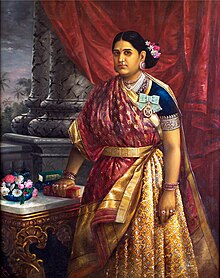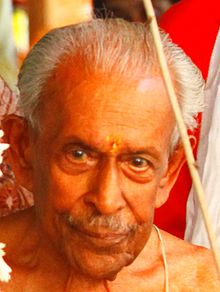Recorded history of the dynasty
Maharani Gowri Lakshmi Bayi,the only Maharani of Travancore to have reigned in her own right for two years before becoming regent
One of the two branches of the Chera dynasty shifted to Venad/Quilon where it merged with the Ay kingdom. Ravi Varma Kulasekhara was the last rulers of this Chera Ay dynasty. Ravi Varma Kulasekara described himself as Ay as well as Komaravarmaan as his mother was a Pandya princess. Numerous places are named after this Tamil Cherai dynasty. Ravi Varma Kulasekhara (1299-1314) invaded the territories of the Pandyas and Cholas and performed imperial coronations at Madurai and Kanchipuram and thus threw of the Pandyan hegemony in the region.[2] However his success was short lived and after him his successors could not hold on to these acquisitions of the Pandyas and Cholas. After 1310 the last Chera-Ay King Veera Udaya Marthandavarma was forced to abdicate in favour of the princesses sent from the Kolathiri kingdom called Attingal and Kunnumel Ranis. But they adopted the titles of Chera-Ay rulers. The line of kings after Ravi Varma continued through the Marumakkathayam law of matrilineal succession. Soon after Ravi Varma's death two princesses were adopted from the Kolathiri Royal family and installed as Ranis or Queens at Attingal. The Venad Royal family continued thus in the female line. Whenever there were no females to take forth the line, princesses were adopted from the Kolathiri family, the latest adoption being in 1994.[3] Umayamma Rani who reigned towards the end of the 17th century was a prominent ruler. Marthanda Varma, the "maker of modern Travancore" and Dharma Raja were powerful rulers who reestablished the power of monarchy in the state and destroyed that of the nobles. By the early 19th century the kingdom became a princely state under the British. Swathi Thirunal was one of the most popular rulers of the 19th century. The regency of Sethu Lakshmi Bayi was a time which heralded many new reforms which were continued by Chithira Thirunal Balarama Varma.
Padmanabha Dasas
Padmanabhaswamy Temple dedicated to the patron deity of the family
Adoption
Maharaja Karthika Thirunal Rama Varma of Travancore successfully repulsed the invasion of Tipu Sultan
Maharani Bharani Thirunal Lakshmi Bayi was adopted from the related Kolathiri royal family
Rajah Rama Varma, and 2 females were adopted and Marthanda Varma was born to one of these princesses.[9] In 1718 a princess was adopted, whose son was the later king Dharma Raja and whose great grandson was the poet Irayimman Thampi . In 1748 again four princesses were adopted and Balarama Varma (1798–1810) belonged to this line.[10] The next adoption of 1788 brought forth the famous Maharanis, Gowri Lakshmi Bayi and Gowri Parvati Bayi and all the male rulers up to 1924, the last ruler in this line being Moolam Thirunal.[11] In 1857 two princesses, including Rani Lakshmi Bayi, were adopted from a branch of the Kolathiri family residing at Mavelikara since the 1790s, but by 1901 both these princesses and all their issue died.[12] In 1900 again two princesses were adopted from Mavelikara, granddaughters of Raja Ravi Varma, including the Maharani Sethu Lakshmi Bayi.[13] The latest adoption occurred in 1994.
Titles and precedence
Maharani Sethu Lakshmi Bayi, the last Maharani of Travancore and Senior Rani of Attingal
Chithira Thirunal Balarama Varma,the last ruling Maharaja of Travancore
- The senior most male of the Royal family, born in the female line, to a Rani of Attingal, becomes Maharajah with the title of Sri Padmanabha Dasa Vanchi Pala (Personal Name) Kulasekhara Perumal. Other titles include Shamsher Jang, Raja Rama Raja Bahadur, Manney Sultan etc.
- The senior most female of the Royal family is the Maharani and holds the title of Attingal Mootha Thampuran and is known as Sri Padmanabha Sevini Vanchi Dharma Vardhini Raja Rajeshwari Maharani (personal name).
- The second princess is known as Attingal Elaya Thampuran, third princess as Attingal Kochu Thampuran.
- The heir apparent is known as the Elaya Raja.
- Consort of the Maharani is known as the Valiya Koil Thampuran.
- Consort of the Maharajah is known as the Ammachi and holds the title of Panapillai Amma. The Maharajahs children do not succeed to the musnud under the Marumakkathayam law and instead get a title of nobility, immediately below royalty, namely Thampi. The Maharajahs are only allowed morganatic marriages so as to maintain Marumakkathayam.
Marriage and other customs
The marriages of the princesses are known as Pallikettus [14] while those of the Maharajahs are known as the ceremony of bestowing the Pattum Parivattavum. The form of marriage is Sambandham and the consorts of the princesses are from certain select families of Koyi Thampurans whereas the consorts of the Maharajahs belong to four houses known as Ammaveedus. The spouses of the princesses and Maharajahs are not considered members of the royal house owing to the prevalent Marumakkathayam law. However they received many royal dignities and privileges owing to their position as consorts. Sri Padmanabhaswamy is the chief family deity.Cessation of the practice of mahādanams
The Maharajas of Travancore had been conditionally promoted to Kshatriyahood from Samantha Nair with periodic performance of 16 mahādānams (great gifts in charity) such as Hiranya-garbhā, Hiranya-Kāmdhenu, Hiranyāswaratā, and Tulāpurushadānam in which each of which thousands of Brahmins had been given costly gifts apart from each getting a minimum of 1 kazhanch (78.65 gms) of gold.[15] The Nambudiri Brahmins had stipulated that Rajas of Travancore could retain their dignity of Nair Sāmanta permanently but the Kshatriyhood conferred on them by the yāgās and mahādanams would be valid only for 6 years and thus the latter purchased kshatriyhood at a heavy recurring cost. During 1848, Lord Dalhousie the then Governor General of British India who was also an eager annexationist was appraised that the depressed condition of the finances in Travancore was owing to mal-administration and practices of treasury by the ruling elite.[16] Lord Dalhousie, who was indignant at the colossal wasteful expenditure of Travancore state treasury through mahādanams among others, instructed Lord Harris Governor of Madras, warn the Rāja under the ninth article of the treaty of 1805. On 21 November 1855, Lord Harris dispatched a strongly worded communication to the then Rāja of Travancore alias Martanda varma (Uttram Tirunal 1847–1860 A.D) that if he did not put a stop to his periodic re-incarnation as Kshatriya by squandering away huge sums of tax payer's money, among others, his state administration would be taken over by the Madras government. This led to the cessation of the practice of mahādanams and the Rājas of Travancore were unable to purchase their Kshatriyahood further and hence Sāmanthan by dignity presently.Palaces
Kowdiar Palace, The official residence of the Travancore Royal Family
The Royal Family
Uthradom Thirunal Marthanda Varma, present head of the family
Some prominent members of the Travancore royal family today include artists Rukmini Varma (Princess Bharani Thirunal) and her son Jayagopal Varma, writers Shreekumar Varma (Prince Punardam Thirunal), Dr. Lakshmi Raghunandan (Princess Makham Thirunal) and Gowri Lakshmi Bayi (Princess Aswathy Thirunal), musician Aswathi Thirunal Rama Varma, Yathi Verma. After the Constitutional Amendment of 1971, the royal family and its properties and estates were partitioned and divided into two equal halves among the branches of HH Maharani Sethu Lakshmi Bayi and HH Maharani Sethu Parvathi Bayi. However certain legal disputes with regard to the same continued among family members until as late as 1991.[18]














No comments:
Post a Comment